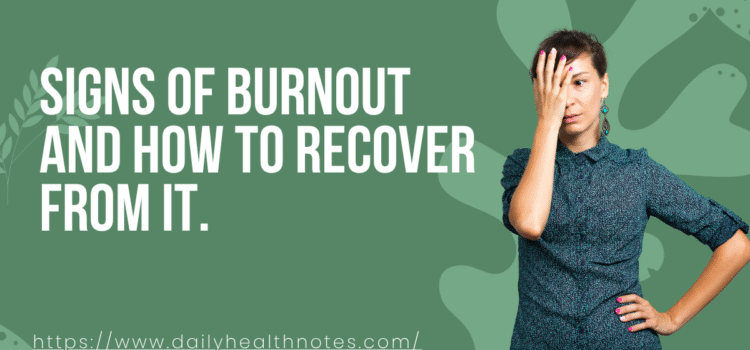
Signs of Burnout and How to Recover from It: A Comprehensive Guide
In today’s fast-paced world, burnout has become a prevalent issue for many people, especially in the workplace and caregiving roles. Whether you’re an employee juggling demanding tasks or a caregiver constantly giving emotional and physical support, burnout can strike at any time. Recognizing the signs of burnout early is crucial for recovery and maintaining a healthy balance in life.
If you’ve been feeling mentally exhausted, overwhelmed, or disconnected from your work or personal life, you might be experiencing burnout. But don’t worry—you’re not alone, and there are steps you can take to recover. In this article, we’ll explore the signs of burnout, why it happens, and practical strategies to help you heal and regain your well-being.
What is Burnout?
Burnout is a state of physical, emotional, and mental exhaustion caused by prolonged stress. It often stems from overwhelming workloads, lack of support, or a lack of control over one’s environment. In the U.S., burnout has become an increasingly common issue in various sectors, including healthcare, education, and corporate industries.
Statistics and Data
According to a report from Gallup, 23% of U.S. workers report feeling burnt out very often or always. Furthermore, NPR and The American Psychological Association have both highlighted the rising cases of burnout among caregivers, particularly during and after the COVID-19 pandemic.
Why Burnout Happens
Burnout can occur due to several factors, including:
- Excessive workload: Working long hours without sufficient breaks or manageable tasks.
- Lack of control: Feeling powerless over your tasks, schedule, or environment.
- Poor work-life balance: Struggling to balance personal life with professional demands.
- Unclear expectations: Not knowing what’s expected of you or having ambiguous roles.
- Lack of recognition: Feeling undervalued for your hard work or efforts.
Common Signs of Burnout to Watch Out For
Recognizing job burnout symptoms or caregiver burnout symptoms early on can help you take action before it worsens. Here are some common signs that you may be experiencing burnout:
1. Chronic Fatigue and Mental Exhaustion Symptoms
If you’re constantly feeling drained, even after a full night’s sleep, mental exhaustion could be a sign of burnout. Mental exhaustion symptoms include trouble concentrating, feeling foggy, and a lack of motivation to complete tasks.
- What to Look For: Feeling physically and mentally tired all the time, no matter how much rest you get.
- Solution: Prioritize quality sleep, take breaks during the day, and reduce multitasking.
2. Feeling Overwhelmed and Irritable
Burnout often leads to a feeling of being overwhelmed, which can trigger irritability. If you’re snapping at coworkers, family members, or feeling emotionally drained, this could be a sign of burnout.
- What to Look For: An inability to manage stress and frequent mood swings.
- Solution: Practice relaxation techniques, such as deep breathing or mindfulness, to help manage emotional responses.
3. Detachment and Cynicism
When burnout sets in, it’s common to experience a sense of detachment from your work or relationships. You may feel disconnected or uninterested in tasks you once enjoyed or used to find meaningful.
- What to Look For: Feeling indifferent toward work or people and developing a negative outlook.
- Solution: Take a step back and reconnect with your core values. Seek activities that rekindle your passion and sense of purpose.
4. Physical Symptoms (Headaches, Insomnia, etc.)
Burnout isn’t just mental; it can also manifest physically. You might experience frequent headaches, stomach problems, or even sleep issues like insomnia due to constant stress.
- What to Look For: Unexplained physical symptoms, like muscle tension, headaches, or digestive problems.
- Solution: Schedule time for relaxation and self-care, such as yoga, exercise, or going for a walk.
5. Declining Job Performance
When experiencing burnout, you may notice a drop in the quality of your work. Tasks that were once easy might seem more difficult or time-consuming.
- What to Look For: Decreased productivity, lack of creativity, or missed deadlines.
- Solution: Break tasks into smaller, more manageable pieces and ask for help or delegate where possible.
How to Recover from Burnout
If you’re noticing the signs of burnout at work or in your caregiving role, it’s essential to take immediate steps to recover and rebuild your well-being. Here’s how you can start:
1. Take Time Off and Rest
The first step in recovery is to give yourself permission to rest. Taking time off from work or caregiving duties is vital for mental recovery. Even short breaks during the day or a weekend getaway can help clear your mind and restore your energy.
- Tip: Use your vacation time and take breaks throughout the day to avoid burnout. Disconnecting from work emails or social media can also provide much-needed mental space.
2. Set Boundaries
One of the primary causes of burnout is feeling overwhelmed due to a lack of boundaries. Establishing clear boundaries between work and personal life is crucial for long-term recovery.
- Tip: Set specific work hours and avoid checking emails or taking calls outside of those hours. Learn to say “no” when your plate is already full, and ask for help when needed.
3. Practice Self-Care
Self-care is vital when recovering from burnout. Take time for activities that help you relax and rejuvenate, whether it’s reading a book, taking a hot bath, or engaging in a hobby you enjoy. Exercise, healthy eating, and mindfulness practices like meditation can also help you heal.
- Tip: Commit to at least 30 minutes a day for self-care activities, whether it’s physical exercise or mental relaxation.
4. Seek Support
Talking to a mental health professional or joining a support group can make a significant difference in overcoming burnout. They can provide expert insights and coping strategies for managing stress and regaining balance.
- Tip: If you’re struggling, consider reaching out to a therapist or counselor. Many employers offer Employee Assistance Programs (EAPs) for confidential support.
5. Reevaluate Your Workload and Expectations
If burnout stems from work, it’s important to evaluate your workload and set realistic expectations. Speak with your manager or supervisor about adjusting your responsibilities or finding ways to make your workload more manageable.
- Tip: Have an open conversation with your employer about the possibility of delegating tasks or taking on a reduced workload temporarily.
6. Engage in Meaningful Activities
Burnout often leads to a disconnection from the things that once brought joy. Re-engage with activities that you love, whether it’s spending time with family, pursuing a creative hobby, or volunteering for a cause you care about. These activities can help bring a sense of purpose back into your life.
- Tip: Schedule time each week for activities that align with your values and interests.
Expert Insights on Recovering from Burnout
Dr. Christina Maslach, a leading researcher on burnout, notes that the best way to recover is by re-establishing balance and support. “Burnout is a result of ongoing stress without adequate recovery,” she explains. “It’s essential to create conditions in which people can thrive, both at work and in life, with clear boundaries and adequate self-care.”
Conclusion: Healing from Burnout
Burnout is a serious issue that can affect your physical, emotional, and mental health. Recognizing the signs of burnout early is essential to avoid long-term consequences. By taking proactive steps such as resting, setting boundaries, practicing self-care, and seeking support, you can recover from burnout and regain your well-being.












